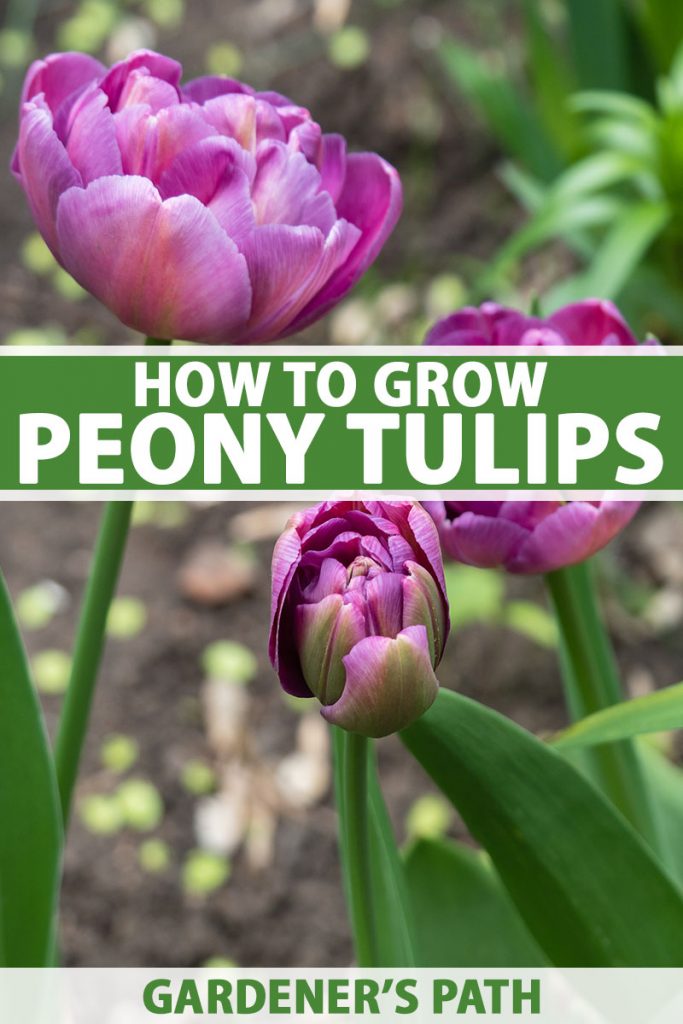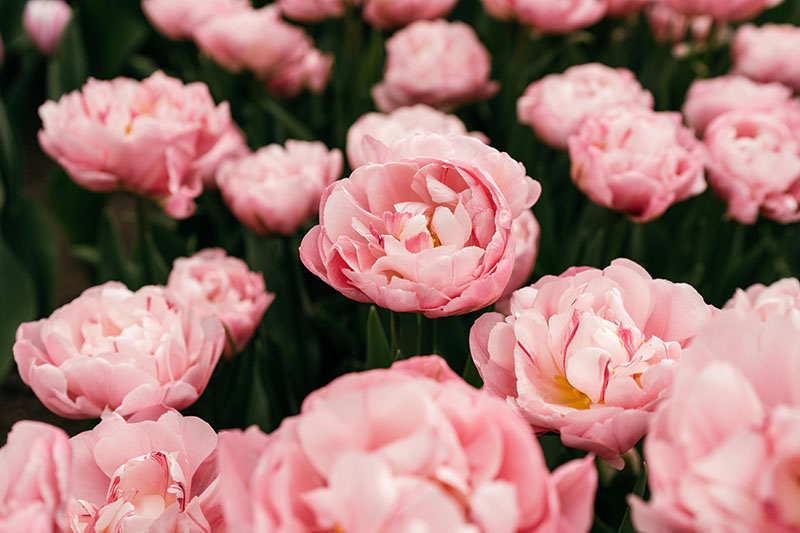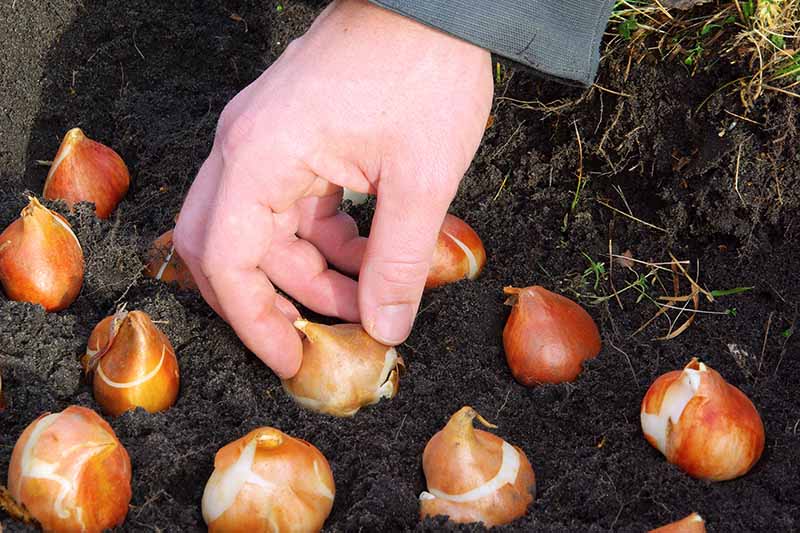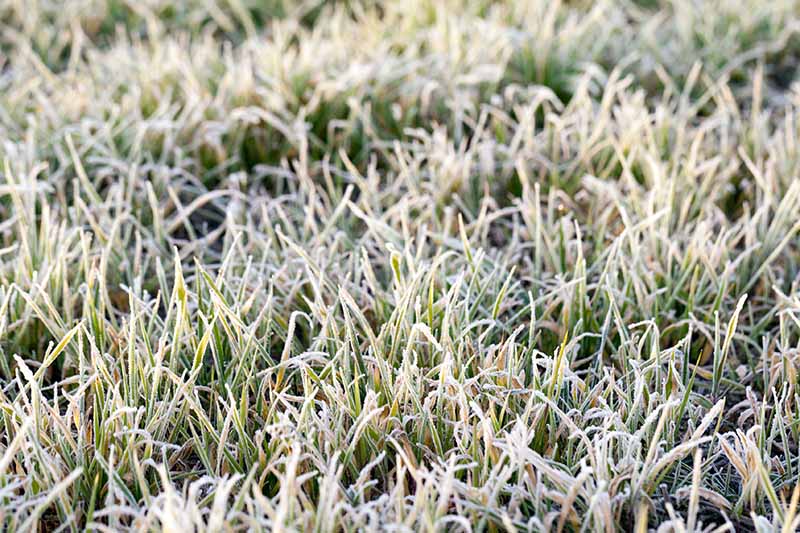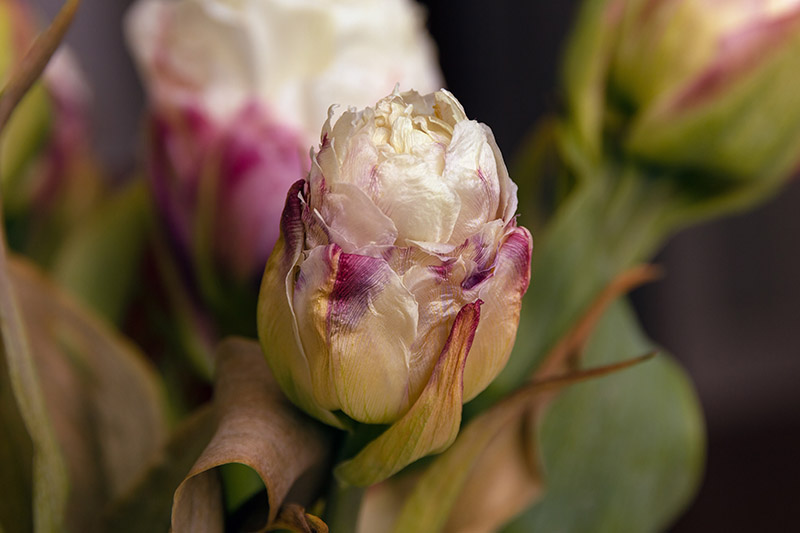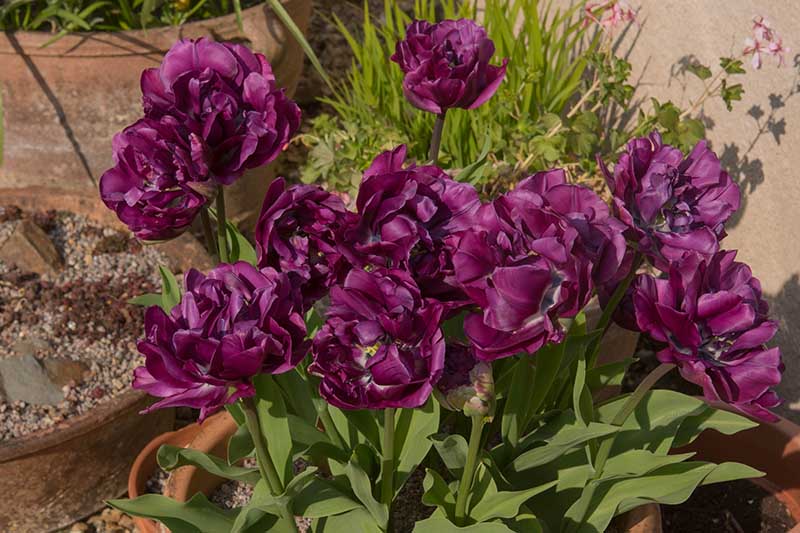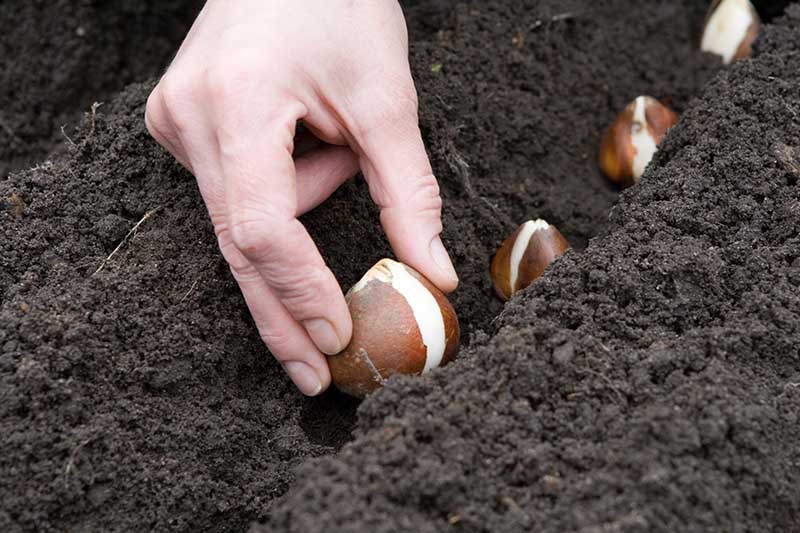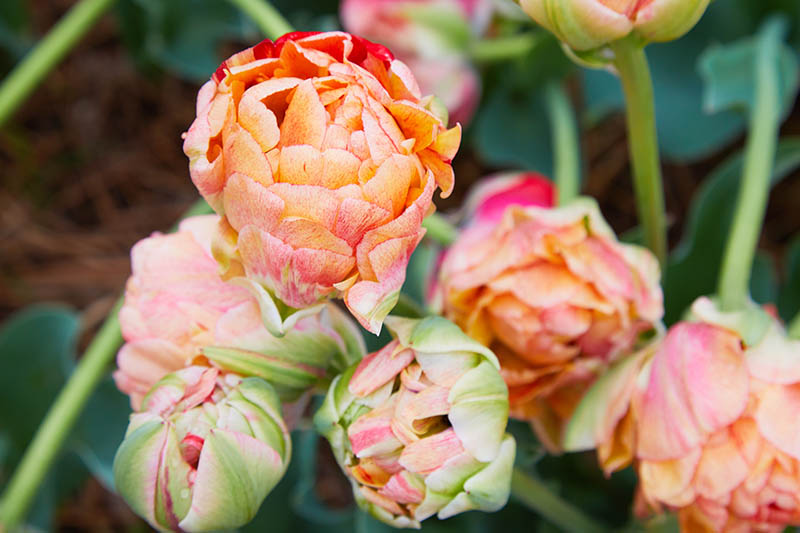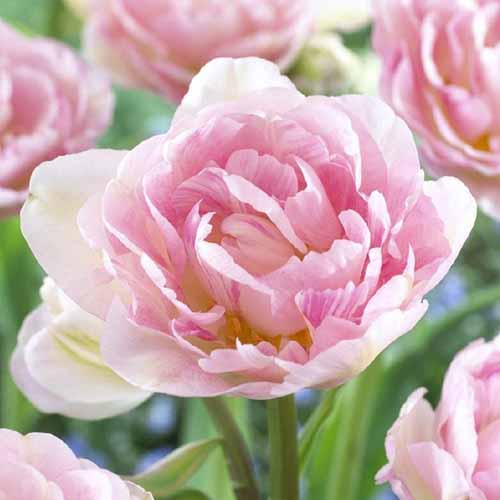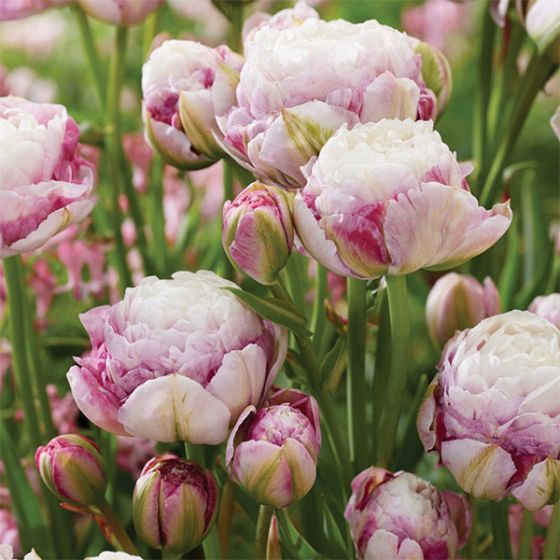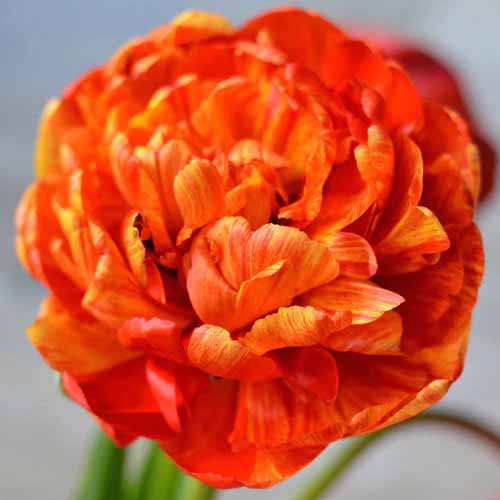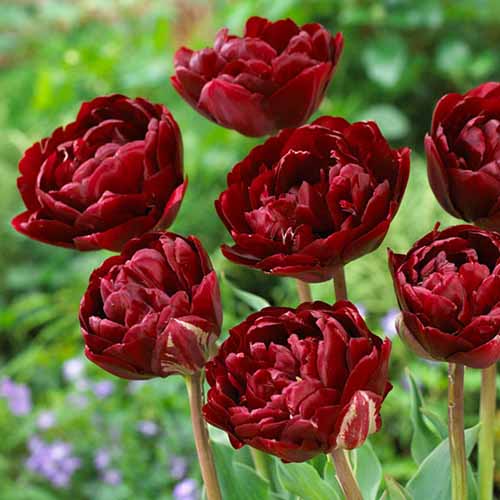But the two are entirely different flowers. Peonies are usually herbaceous perennials or woody shrubs that grow from thick tubers – which I have recently seen unearthed in my front flower bed because my dog has inexplicably been digging up one of my peonies over and over again… Peony tulips, on the other hand, are grown from bulbs. We link to vendors to help you find relevant products. If you buy from one of our links, we may earn a commission. Read more about tulips in our growing guide. True to their other name – double late tulips – these bloom later in the spring than other members of the Tulipa genus, usually around May or June. The blooms last for around two weeks, giving you a beautiful span of time to enjoy their peony-like loveliness. The blooms are four inches wide, making them one of the largest, most stunning Tulipa varieties around. Best of all, double late tulips smell delightful. And since these flowers thrive in USDA Hardiness Zones 3 to 8, I’m planting a set of bulbs in my Alaskan flower bed this fall for a late spring show of double-petaled color. So, if you like tulips but want to grow a variety that’s bigger and more elegantly showy, this guide will tell you everything you need to know. Here’s what I’ll cover:
What You Should Know About Tulipa Flowers
Before you begin planting, there are a few things to keep in mind so you can enjoy the most fulfilling growing experience. Like other types of tulips, double lates produce one flower per bulb. I originally purchased 10 bulbs before realizing that in order to produce a fuller look in my flower beds, I’d need many more. So I ordered 10 more bulbs, plus 20 double-flowering daffodils that should bloom at around the same time. Planting between 40 and 60 bulbs at once might seem like an exhausting amount of work, but with perennial peony tulips, you might be rewarded year after year with gorgeously layered blossoms. Did you catch that key word? Might. Species tulips, along with a few specific hybrids like ‘Darwin’s’ and ‘Greigii,’ are more likely to come back year after year. But many hybridized bulbs may struggle to bloom in their second year if they aren’t given near-perfect growing conditions. The bulbs are prone to rot, disease, and deformity, resulting in sub-par blooms in the second year. Or none at all. Peony tulips are average naturalizers. There’s a chance that they’ll come back healthy and even produce daughter bulbs, but only under ideal conditions. Cold winters and hot, dry summers are perfect for them, which explains why the tulips in the front garden beds of my childhood home in Bozeman, Montana came back every year that I lived there. You can help these lovely blooms thrive in their second year by choosing the healthiest bulbs possible from a reputable nursery, whether it’s a brick-and-mortar store or online. They should be firm and weighty, with their papery skin intact. The bulbs should also be large. Somewhere in the 10 to 12 centimeter (3.9 to 4.7 inches) range is ideal. The larger the bulb, the more food and energy reserves are stored inside, resulting in a stronger, more beautiful flower in the spring. (Stay tuned to find out where I got my guaranteed 12-centimeter bulbs…)
When to Plant
The best time to put flowering bulbs in the ground is in the fall, six to eight weeks before your area’s average first hard frost or freeze (when temperatures fall below 32°F), and when soil temperatures are around 40 to 50°F. This gives the bulbs time to establish roots before they go dormant for several months over the winter. Here’s a breakdown of the average first light frost dates for USDA Hardiness Zones 3 to 8. If you get your tulips in the ground about four weeks before this date, they’ll be established enough to withstand a hard frost a couple of weeks later:
Zone 3: September 8-15Zone 4: September 21-October 7Zone 5: October 13-21Zone 6: October 17-31Zone 7: October 29-November 15Zone 8: November 7-28
Make sure you get your bulbs in the ground at least four weeks before your average first light frost date, and six to eight weeks before your average first hard frost date. You can read more about whether or not you still have time to get flowering bulbs in the ground this season in this article. The plants will need about 12 weeks of soil temperatures below 50°F. If you don’t think you’ll get this in your climate, you may need to bring the bulbs indoors during the summer, when they’re completely dormant. Store them in brown paper bags and put them in your refrigerator’s crisper drawer for 12 to 14 weeks. Just don’t forget to take them out in the fall and plant them! If I were you, I’d put a note in my gardening journal, and then back that up with a reminder on my phone. Sometimes it really is smarter than I am.
Choosing a Location
Before you plant, you need to pick the perfect location. Choose a planting site with full sun or part shade. This translates to about six to eight hours of sun a day. If you live in a warmer climate, you’ll definitely want to make sure you stay in the six-hour range.. The area should have loose, well-draining soil. A constantly damp bulb turns into a diseased bulb very quickly. Avoid planting bulbs near perennials that’ll need tons of water during the summer. (Remember how they love hot, dry summers? Try to maintain that as much as possible!) On the soil side of things, a good spot to plant bulbs is in a raised bed, which naturally has better drainage than hard-packed earth. But some gardeners warn against planting bulbs in raised beds because they may be at the whim of temperature fluctuations. If you bury them at least eight inches deep in a raised bed, however, they should grow without any issues. Mine will bloom in spring in my rock-bordered flower bed, which is essentially a raised bed. You can even plant them in terra cotta or wood containers, where they’ll receive good drainage and you won’t have to worry as much about squirrels digging them up. Make sure the pot is at least 15 inches tall and 18 inches in diameter to give the bulbs plenty of room to grow.
How to Plant
The first thing you should know is that, ideally, bulbs will go in the ground as soon as possible after you purchase them. If you can’t plant them right away, store them in a cool, dark place until you can. But don’t forget about them! You don’t need to fertilize them when you first plant them – they’ve got all the food they need, stored inside the bulb. Make the trench as long or short as you want. It all depends on how many bulbs you’ll be planting! Stand Up Bulb Planter If you don’t have more than 10 to plant, you can simply dig individual six to eight-inch holes with a trowel or a bulb planter, like this one from Garrett Wade. Place your bulbs inside the hole or trench, spacing them four to six inches apart. In containers, you can plant them so close they’re almost touching, for a fuller look when they emerge in the spring. Make sure you place the bulbs pointy-side up. The autumn after their first blooming spring and dormant summer, a year after they were planted, you’ll want to apply a slow-release 10-10-10 or 10-15-10 (NPK) fertilizer to the top of the soil, and water it in immediately afterward. To keep squirrels away, simply cover the freshly dug area with mulch so that it doesn’t look disturbed. Use your fallen autumn leaves as free mulch, or if you don’t have any, you can use bark mulch. Squirrels don’t actually eat bulbs. They’re mostly attracted to disturbed soil, which signals that something’s recently been buried underneath, and they dig to find out what it is. After planting and mulching, give the bulbs a deep watering. Since you planted them six to eight inches down, you’ll need to provide at least two to three inches of water. After waiting a few minutes, check the soil with a ruler. If it’s wet six to eight inches down, you don’t need to add more water. If the soil down where you planted is dry, add another two inches and repeat the ruler trick. Water deeply one more time about five days before your area’s average first freeze date, or keep an eye on the extended forecast for the first predicted freezing temperatures for a more accurate last-watering date. You’ll start watering again when the ground thaws in the spring, or in December or January if you live in a warmer location in Zones 7 or 8. If there isn’t rain in springtime, give the plants about two thirds of an inch of water once a week. Make sure you mark the spot where you plant your flowers so that you know where to expect them in the spring.
How to Care for Your Peony Tulips
Come late April or early to mid-May, you’ll start to see green foliage poking through the soil. It’s a blissful feeling, isn’t it? You really don’t have to do much at this point. Just give them that two thirds of an inch of water if there’s no rain, and watch them bloom into dazzling peony-shaped beauties. You’ll be able to enjoy the flowers for about two weeks. In locations with a few hours of afternoon shade, they’ll last even longer. To use them as cut flowers, cut them at a 45-degree angle when they’re still buds that have just barely begun to open so you can see the color of the petals. Trim off any leaves that would be underwater in your selected container so that they don’t rot, and then place the cut blooms in a vase of clean water. Replace the water every day, making a fresh cut on the stem each time. You’ll get to watch your peony tulips bloom on your windowsill, where they should last for at least a week or more if you give them some homemade cut flower food. For more tips, read our article on how to make cut flowers last longer. Or, you can just leave them in the garden and enjoy seeing them every time you step outside. I like to do both. Once the foliage begins to wilt in the garden, cut the faded bloom and flower stalk off the stem. But let the rest of the foliage die back naturally so it can continue to provide nutrients and energy to the bulb for summer, fall, and winter storage. In the summer, when they are dormant, do not water your peony tulips at all. As mentioned, you can give them a dose of slow-release fertilizer in the fall, along with one deep watering. You’ll resume regular watering again in the spring, as needed. Here are three of my favorite peony tulip cultivars, plus the mix that I decided I just had to have for my flower beds.
Angelique
Do you love a classic, soft-pink peony look? Then ‘Angelique’ is your girl. She’ll give you 16- to 20-inch-tall plants in the spring, haloed in light pink petals. ‘Angelique’ I think she’d look lovely against a dark blue or white house. Find 12-centimeter bulbs at Eden Brothers and have them shipped to you just in time for your growing zone’s best planting time.
Double Surprise
For a bloom that will delight and, yes, surprise you with its delicious flounces of pink and white petals, try ‘Double Surprise.’ Ringed with dark pink at the edges, the petals turn lighter toward the center of the flower, resulting in a dramatically gorgeous look. ‘Double Surprise’ Since I’m on a house-tangent, I think ‘Double Surprise’ would look fantastic against a white, tan, or light-blue home. Find bulbs online at Nature Hills Nursery.
Pep Talk
If you know you’re going to need a pick-me-up in the spring, plant ‘Pep Talk’ in your garden. ‘Pep Talk’ is perhaps the loveliest flower I have ever beheld, and it’ll do more than just cheer you up come May. ‘Pep Talk’ It’ll positively enthrall you with its radiant beauty, potentially even bringing you to joyous, cathartic tears. The large, 14- to 20-inch-tall, double-layered blooms are dark pink-red to pinkish-white, and everything in between. Find your 12-centimeter bulbs at Eden Brothers. They’ll ship to you just in time for planting in your zone.
Sunlover
‘Sunlover’ is an outstanding selection with huge blooms that start out in a glorious shade of yellow with reddish-orange highlights. As they open up, the color appears to change in front of your very eyes to a deep orangish-red, atop 24-inch stems. ‘Sunlover’ Add ‘Sunlover’ to your backyard with 12-centimeter bulbs available from Dutch Grown in packages of 10, 25, 100, 500 and 1,000.
Tom’s Favorite
Do you have a yellow house? Or maybe a green or tan one? Then trust me on this: you need ‘Tom’s Favorite’ in your flower bed. These gorgeous, dark red blooms dazzle with their layered petals. They will make your heart skip a beat in the springtime, and every ounce of effort you put into these bulbs in the fall will be beyond worth it. ‘Tom’s Favorite’ Even better, the 14- to 20-inch-tall flowers mature to deep purple by the end of their second week. Two colors in one bloom? Count me in. Find bulbs online at Eden Brothers, and they’ll ship you 12-centimeter bulbs at the right time for your growing zone.
Double Pink Mix
For those of you who adore shades of purple, like I do – purple and white were my wedding colors! – you won’t want to miss this mix of white, pink, and purple peony tulips. I’ve got 20 of these delightful bulbs coming my way, and I’m actually excited to dig a trench to plant them. And I don’t like digging trenches. ‘Double Pink’ Mix But when I see the 14- to 20-inch-tall flowers bloom in a gorgeous blend of color this spring, every sore muscle will be forgotten. I found my 12-centimeter bulbs online at Eden Brothers, and since I’m in Zone 4, they’ll be here in mid-September.
Quick Reference Growing Guide
The Prettiest Peonies That Ever Weren’t
All winter, when snow falls heavily on my entire yard and sits there for months, I’ll be thinking about my double lates, waiting patiently underground for their time to shine. I can’t wait to share some photos this coming spring. And if you’ve ever grown these double-petaled beauties, I’d love to hear your stories, comments, and questions below. Would you like more options? Then read our article “Types of Tulip Flowers: 15 Beautiful Divisions” or take a look at some of these other tulip guides next:
How to Grow and Care for Parrot Tulips in the Spring Garden9 Reasons Why Tulip Leaves May Turn Yellow Prematurely17 of the Best Multiheaded Tulip Varieties
